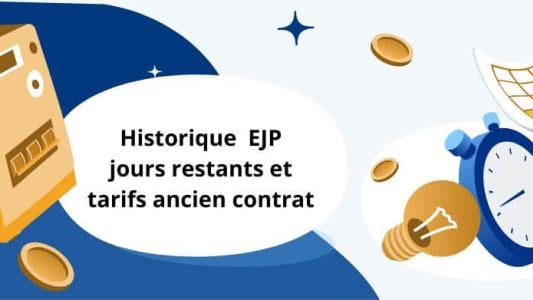The French Energy Market: History, Evolution and Providers in 2025
Being one of the most populated countries in Europe, France is also one of the continent's largest energy markets. It also coincidentally a highly competitive market since it opened up to competition in 2007. But what exactly does this competition mean for consumers, and how has it changed the face of the French gas and electricity business system? More info about the Hexagone's energy market and its evolution below.
A brief history of the French energy market

For quite a while, France possessed a unified and closed energy market, with EDF and GDF respectively holding the monopoly for the provision of electricity and gas nationwide.
It is only in the mid-nineties that, in conjunction with European directives, the system started to open up to competition and thus allow tens of new energy providers to appear on the market from 2007 onwards.
Here is a chronology of the main milestones.
| Date | Event |
|---|---|
| 1996 | First EU directive about an opening up of the electricity market |
| 1998 | First EU directive about an opening up of the gas market |
| 1999 | The French energy market opens up for companies with consumptions of 100+ GWh. |
| 2000 | The French energy market opens up for companies with consumptions of 16+ GWh |
| 2003 | The French energy market opens up for companies with consumptions of 7+ GWh |
| 2004 | The French energy opens up for companies and local authorities throughout the EU |
| 2004 | Production, transport, distribution and provision of energy are now all separate activities |
| 2007 | The EU market opens up to competition for all EU residents. EDF and GDF no longer hold a monopoly. |
| 2016 | Companies are no longer bound to the French Regulated Tariffs The Commission de Régulation de l’Énergie (CRE) now fixes the Regulated Tariffs for private consumers |
✅ The opening of the market to competition
⚖️ How did the liberalisation of the French market operate?

At the dawn of the 21st century, the European electricity market committee started envisioning a new direction for energy regulations in the Union. The decision was taken to open up production and supply activities to competition, and as a result, the monopolies throughout the EU came to an end.
This enabled French gas and electricity producers to set up their activities freely in France and for new suppliers to commercialise offers for French individuals and professionals. The distribution and network sectors were also shaken up, with the creation of ERDF and the RTE. The only sector that remains as is the transport of electricity, as liberalising it presented no gain for the consumer and the balance between supply and demand for energy would become complex to manage.
However, even with these new rules, it is still complicated for new players to position themselves on the market due to high entry costs and low margins. Even though there are now near to 30 energy providers in France, EDF still holds around 80% of the market even 13 years since the introduction of competition.
The benefits of competition for consumers
While the concept of competition can sometimes have negative connotations, in the context of the energy market it has arguably enabled consumers to reap a number of benefits and guarantees. These include:
- A wider choice of suppliers: consumers can freely choose either a historical provider (EDF and Engie) or a new, alternative one (Ekwateur, Planète Oui, Total Direct Energie...).
- Transparency and comparison: pricings are clearly stated on providers' websites, so consumers can compare regulated tariffs (set by the State and marketed by EDF and Engie) to new market offers (freely set and marketed by new suppliers).
- New, interesting offers such as indexed and fixed-price offers, which promise guaranteed discounts compared to the regulated tariffs, or protection from price increases over a set period of time.
- An increase in green offers: new, smaller providers offer green electricity and green gas plans, thus helping develop renewable energies in France.
✔️ Guarantees offered to the consumer
On top of receiving discounts on their energy bills, consumers can also rest assured that if they opt for a new alternative provider they will be guaranteed the following:
- The same quality of electricity and gas as with the historical suppliers
- Equivalent supply guarantees
- Equivalent services at the exact same prices - regardless of your supplier, you will always be assisted by technicians from the ENEDIS and GRDF networks if you experience an energy emergency
- No interventions or changes to your meter needed when you switch to a new supplier - and thus no extra costs or energy cuts
- The possibility of cancelling your contract at any time for free, no questions asked
- The possibility of switching back to historical providers and regulated prices whenever you wish
There is thus nothing to lose when you switch to an alternative supplier, it's free and you won't even have to inform your former provider of the change - your new one will take care of the process for you!
France's energy market: Who Does What?
In France as of 2020, only the supply and sale of energy are open to competition. The transport and distribution of energy, on the other hand, are still subject to a monopoly, as follows:
- RTE is in charge of electricity transmission
- GRTgaz and TIGF handle the transport of gas
- ENEDIS distributes electricity over 95% of the territory
- GRDF distributes gas over 95% of the territory
- Local distribution companies (ELD) take charge of energy distribution for the rest of the French territory
⚡ French energy providers in 2020
With around 30 energy providers on the French market today, there is bound to be one that will suit your needs and budget. Here are just some of them:
 | EDF still dominates the electricity market with its flagship offer: the Tarif Bleu Ciel, which applies the French regulated tariffs. But in recent years, the provider has introduced additional offers, such as green energy plans - even though these tend to remain on average above the prices of quite a few of the competitors. |
 | Engie, on the other hand, is also a major French provider with its million customers. Like EDF, it has also developed new types of options, such as green electricity and fixed prices offers. It has also introduced French clients to Happ-e, which is its brand that comes with indexed prices for competitive prices. |
 | TotalEnergies (formely Total Direct Energie) was born from a fusion between Total Spring and Direct Energie in 2019. It is EDF and ENGIE's most powerful competitor, thanks to its high-quality customer service and attractive prices. |
 | Eni is an Italian supplier now available in France, which provides electricity and gas to its customers. |
 | With its 50,000 members, Enercoop is the largest cooperative in France. It is also the first supplier to guarantee green electricity from small French producers. |
Other providers include quite a few green suppliers at competitive prices. For instance, Mint Energie markets the green offer with the lowest kWh price on the French market. As for Octopus Energy, it financially rewards its customers who pay close attention to their consumption and strive to reduce it.








